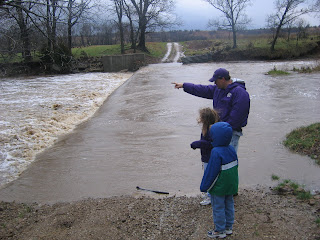One never knows what images one is going to hold in memory, returning to the city after a brief orgy in the country. I find this morning that what I most vividly and longingly recall is the sight of my grandson and his little sunburnt sister returning to their kitchen door from an excursion, with trophies of the meadow clutched in their hands—she with a couple of violets, and smiling, he serious and holding dandelions, strangling them in a responsible grip. Children hold spring so tightly in their brown fists—just as grownups, who are less sure of it, hold it in their hearts.
While the passing of fifty years has not been kind to the first sentence in this paragraph, that last sentence is timeless. It’s one of many I wish I had written.
In the midst of this sabbatical, the paragraph as a whole struck a chord for me, not only because it will be interesting to see what images stick in my memory (and those of Dana and the kids) after we return to Sioux Falls, but also because its been interesting to see which images are summoned to the surface by the day-to-day events of our current stay.
The local electric company has undertaken the task of clearing the trees and brush along the rural power lines. They’ve hired a company called Poor Boys out of Fairplay, Missouri, which has had a crew and a couple million dollars of massive machines running up and down the roads around here. Yesterday, they came to clear out some trees around the power lines that lead from the road to the trailer we’re living in. The mobile home we’re currently living in sits on the same slab that held the double-wide mobile home I grew up in, so these trees, which stand just east of the trailer, suddenly became the source of some of those images to which White was referring.
Just beyond the trees, Dad and I (mostly Dad) were loading the trailers with round hay bales to take back south. While the Poor Boys took out only a few trees along the power line, Dad mentioned that he wanted to take out the whole bunch of them, as the land is currently producing nothing when it could go to grass to feed cattle. There is nothing picturesque about the little clump of trees. It consists entirely of what my dad calls scrub oak (I think), spindly little trees that are neither tall, nor imposing, nor particularly beautiful. However, when I was younger—probably somewhere between ten and thirteen—my younger brother and I used to go out and play in these meager trees. We were in Boy Scouts at the time and learning to lash things together. A little clearing among the tree trunks became something of a hideout, complete with makeshift “doors” lashed together and hung on opposite sides of the clearing. The “doors” were about the size of those swinging doors in the entrance to a saloon on Gunsmoke or Bonanza or some other western. But, of course, our doors were hung from the limbs above. I think one has to be an Eagle Scout before he learns to lashing together hinges.
As I recall, the trees also contained an old well and a trash mound that was a regular source of discovery—old bottles and pieces of rusted metal from contraptions both familiar and foreign. These details later became part of a meager little poem written for my M.A. report, which was titled “Under the Rocks,” after a line from Norman MacLean’s A River Runs Through It.
Under the Rocks
I
Removing first the rocks and then the one-
by-twelves above the well, we dropped the stones
and broken bottles captured out of ash,
and waited for the splash that would not come.
II
We turned to stacking—laid our dog to rest
beneath a humble mound of limestone, left
the blackened cinders under the fire ring
after our campout with Dad—our first and last.
III
We buried Grandpa—who took us fishing, turned
the rocks and sifted through the soil, endured
the shining grubs, some stretching toward the sun,
some playing dead, afraid to be unearthed.
Watching some of those trees come down, and anticipating the eventual clearing of the whole clump, I encountered a bout of nostalgia, of course. I also found myself thinking about why such a meager clump of trees should have an emotional resonance. This led to some reflection on the nature of the imagination (or perhaps just my imagination). As much as I love the prairie and the wide open spaces, it seems to me there is something about confinement that sparks the imagination. Perhaps this is why people generally prefer forests and mountains, with their nooks and crannies, the imagination expanding with each unexpected clearing, each surprising discovery. I thought of Lewis’s wardrobe, with its confinement that opens up into a world of imagination and wonder. I suppose each of us—particularly as children—finds the necessary nooks and crannies—whether they are in a wardrobe up in the attic, or in a clump of trees east of the mobile home.







